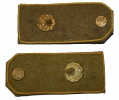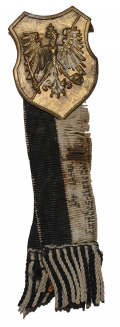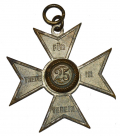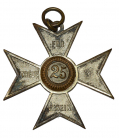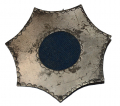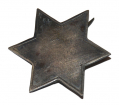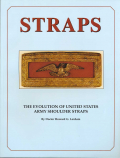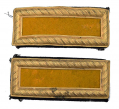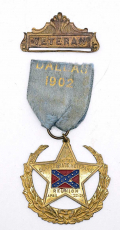site search
online catalog
Insignia & Badges
Showing 1 to 20 out of 78
WWII JAPANESE SEW ON CAP STARS
Pair of star cap devices which are unissued and still attached together. Excellent condition. [gr] [ph:L] ~~~~~~~~~~~~~~~~~~~~~~~~~~~~~~~~~~~ THIS ITEM, AS WITH ALL OTHER ITEMS AVAILABLE ON OUR… (160-140). Learn More »
WWII JAPANESE NCO SHOULDER STRAPS
Excellent condition; rank of Sergeant. [gr][ph:L] ~~~~~~~~~~~~~~~~~~~~~~~~~~~~~~~~~~~ THIS ITEM, AS WITH ALL OTHER ITEMS AVAILABLE ON OUR WEB SITE, MAY BE PURCHASED THROUGH OUR LAYAWAY PROGRAM.… (160-135). Learn More »
WWI IMPERIAL GERMAN PRUSSIAN VETERAN’S RIBBON
Ribbon itself is fraying and has some staining on it. [gr][ph:L] ~~~~~~~~~~~~~~~~~~~~~~~~~~~~~~~~~~~ THIS ITEM, AS WITH ALL OTHER ITEMS AVAILABLE ON OUR WEB SITE, MAY BE PURCHASED THROUGH OUR… (160-506). Learn More »
WWI IMPERIAL GERMAN BAVARIAN 25 YEARS SERVICE MEDAL
Medal is missing ribbon but both rings are still present. [gr][ph:L] ~~~~~~~~~~~~~~~~~~~~~~~~~~~~~~~~~~~ THIS ITEM, AS WITH ALL OTHER ITEMS AVAILABLE ON OUR WEB SITE, MAY BE PURCHASED THROUGH OUR… (160-522). Learn More »
WWI IMPERIAL GERMAN BAVARIAN 25 YEARS SERVICE MEDAL
Medal is missing ribbon but both rings are still attached. [gr][ph:L] ~~~~~~~~~~~~~~~~~~~~~~~~~~~~~~~~~~~ THIS ITEM, AS WITH ALL OTHER ITEMS AVAILABLE ON OUR WEB SITE, MAY BE PURCHASED THROUGH… (160-507). Learn More »
WORLD WAR TWO GERMAN UNISSUED PAIR OF LUFTWAFFE SIGNALS OFFICER COLLAR TABS
Tabs are unissued and are still held together by a string. The insignia consists of two flying gulls within a wreath on a saddle-brown cloth background outlined in twisted silver cord. The gulls and… (160-60). Learn More »
UNUSED GERMAN WORLD WAR TWO ARMY BREAST EAGLE
The German army originally adopted a slightly modified version of the NSDAP’s national eagle with instructions to have it applied to all steel helmets, visor caps, and tunics by May 1, 1934. The… (160-59). Learn More »
SINGLE SHOULDER STRAP FOR A CAPTAIN OF STAFF
Strap is made of dark blue cloth with a double row of dead bullion for a border. The rank field is of black velvet while the rank of captain is made of bars of heavy gold bullion thread. The underside… (460-1468). Learn More »
NON-DUG HARDEE HAT EAGLE INSIGNIA
Regulation 1858 eagle used on enlisted man's dress (Hardee) hat to loop the side of the dress hat up. It was originally introduced in 1851 as a pompon eagle, attached to the base of the pompon holder… (490-6479). Learn More »
$100.00
SOLD
COLLECTION OF ITEMS BOTH WARTIME AND VETERAN IDENTIFIED TO 8TH IOWA INFANTRY OFFICER
This lot consists of item identified to Lieutenant Spencer Smith of Company A, 8th Iowa Infantry. Smith was born in Ogle County, Illinois on January 14, 1839 and relocated to Iowa with his family in… (460-1466). Learn More »
$995.00
Originally $1,100.00
HANCOCK’S VETERAN CORPS BADGE
Sometimes confused with the Veteran Reserve Corps, or the earlier First Army Corps in the Army of the Potomac, Hancock’s Veteran Corps (sometimes referred to as Hancock’s First Veteran Corps) was… (1179-640). Learn More »
EIGHTH CORPS BADGE
Use of this badge is complicated by confusion between the 8th Corps, which technically was under Lew Wallace and guarded the B&O Railroad in 1864 and George Crook’s “Army of West Virginia,”… (1179-637). Learn More »
CIVIL WAR US IMPORT FRENCH CHASSEUR EPAULETS: 18th MASS AND OTHERS
These green and yellow epaulets were part of the 10,000 unforms ordered in Summer 1861 by the US government from the French firm of Godillot to alleviate uniform shortages and test the usefulness of… (149-44). Learn More »
FIFTH INFANTRY CAPTAIN’S EPAULETS AND KEPI
This set belonged to an unidentified officer in a 5th Infantry regiment judging from the officer’s embroidered hunting horn insignia on the front of the cap with a “5” in the loop of the horn,… (1179-354). Learn More »
SILVER CONFEDERATE ID BADGE RECOVERED NEAR FALLING WATERS - GETTYSBURG POW
This silver badge is crescent shaped and meas. approx. 1.00 inch long. It is engraved around the edges with a linear decoration and engraved on its face is “SKIDS.” Reverse has the remains of a… (2024-29). Learn More »
STRAPS: THE EVOLUTION OF U.S. ARMY SHOULDER STRAPS BY DR. HOWARD G. LANHAM
Originally $27.95, now just $20.00. Brand new copies, softcover, 210 pp. 8 ½” x 11”, numerous b&w photos & illustrations. Published 1988. This extensively researched and documented book… (2024-20). Learn More »
SMITH PATENT CAVALRY SECOND LIEUTENANT SHOULDER STRAPS
This is a very good condition set of Smith patent shoulder straps for a second lieutenant of cavalry, showing strong color to the yellow ground and good gilt left on the brass frame border, stamped to… (2023-3252). Learn More »
CIVIL WAR MUSICIAN’S GROUPING INCLUDING WARTIME IDENTIFICATION DISK, IDENTIFICATION SHIELD, AND FREEMANTLE ROTARY VALVE CORNET/VALVED BUGLE: JOHN J. WEAVER- 10th and 56th PA- AND CUTLER’S BRIGADE BAND 1861-1865
This wonderful grouping includes two wartime identification badges, a rotary valve cornet dating about 1864, along with his GAR membership badge and veteran’s id badge. To top it off, in addition to… (1179-420). Learn More »
DALLAS TEXAS 1902 CONFEDERATE REUNION BADGE
This badge has a foliate bordered pinback top bar with a light blue ribbon- perhaps a bluish-gray originally- with the “DALLAS / 1902” stamped in gold near the top, from which is suspended a gilt… (1179-700I). Learn More »
IDENTIFIED FIRST LIEUTENANT OF INFANTRY SMITH PATENT SHOULDER STRAPS: MARION COUNTY REGIMENT INDIANA LEGION AND 104th INDIANA “MINUTE MEN”
These infantry 1st Lieutenant shoulder straps are the Smith patent, using thin stamped gilt brass in imitation of bullion embroidery for the borders and the rank bars, which are attached to a light… (480-335). Learn More »
Showing 1 to 20 out of 78
Most Popular
Historical Firearms Stolen From The National Civil War Museum In Harrisburg, Pa »
Theft From Gravesite Of Gen. John Reynolds »
Cavalry Carbine Sling Swivel »
Fine Condition Brass Infantry Bugle Insignia »
featured item
RARE EBERLE 1796 CONTRACT MARKED BAYONET
This rare bayonet is marked by the maker in a sunken cartouche with raised letters on the base of the blade reading “Eberle.” Charles Louis Eberle emigrated to the U.S. from Germany with brothers George A. and Henry J. in 1794, arriving in… (1052-86). Learn More »




